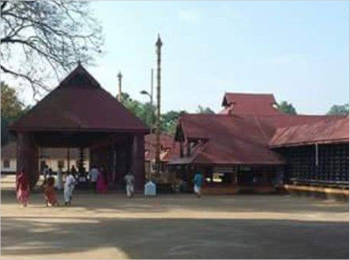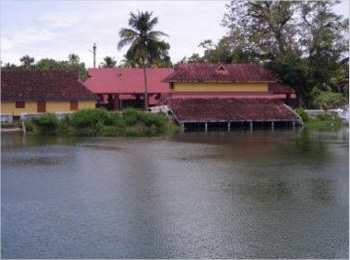- Vishnu
Thuravoor Mahakshethram
- Thuravoor,Kerala
- View on map
- Tell us about this temple
Overview
The Thuravoor Mahakshethram is an ancient temple with 2 deities in the same compound located in Thuravoor nearly 25 kilometers from Kochi. This ancient temple, famous for its artistic splendor and architectural grandeur is among the much-admired places of worship in the state of Kerala. Thuravoor Mahakshethram is the sacred abode of two idols, Lord Sree Narasimhamoorthy and Lord Sree Mahasudarsanamoorthy.
About The Temple

The architecture of Thuravoor Mahakshethram is very impressive and you can see the unique temple architecture tradition of Kerala in them. Here the Narasimhamoorthy idol is in a standing posture which is a unique feature of the temple as the Narasimha idols are usually seen in their sitting positions. There is a huge temple tank in the direct vision of the shrine on the eastern side of the temple and it is believed that the serene and cool waters of the tank provide soothing and calming effect on the Narasimha mind frame of the Lord.
Sree Narasimhamoorthy temple
Though the Narasimhamoorthy temple (on the northern side) is separated by a wall, the two temples are interconnected. The fairly large, square-shaped, copper-roofed Sreekovil is built of granite. The Namaskara Mandapam is ornamented with sculptures of lotus blooms. The granite pillars on the Mandapam also feature highly imaginative carvings. One stone pillar carries the image of Deepalakshmi. The sculptures and murals on the outer walls of the Sreekovil are so beautiful. Kerala's age-old tradition in temple architecture is reflected here. Since the temple was formerly in the Cochin territory, the God depicted is likely to be Sree Poornathrayeesa, the family deity of the Cochin royalty. Nataraja, Indra with his thousand eyes in the presence of Ugranarasimha, Sree krishna, and a damsel with her face turned away from a scene showing a love-lorn couple are some of the pictures that will linger in the mind of a visitor.
The Garbhagriha of the the Sreekovil has two ante-chambers. Here too, the idols of Dwarapalakas are installed in one of them. The Garbhagriha houses a beautiful, four-armed idol of Mahavishnu who is perceived as Ugranarasima. In the corridor on the southern side, there is an idol of Lord Siva. You can view and worship Him through the narrow window in the wall on the southern side.
Narasimha idols are often found in a sitting posture. But here, the idol is on its feet. One may assume that originally this idol in the standing position was originally that of Mahavishnu; and, as a result of poojas and other sacred rituals, it is being perceived as Ugranarasimha. Connoisseurs of art within and outside Kerala agree that the sculptures, relief works and carvings on the southern side of the Sreekovil are priceless works of art. Scholars from afar often visit the temple for an in-depth study of these masterly creations. One can see here nine different perceptions of Narasimha including Ugranarasimha, Lakshmi Narasimha and Yoga Narasimha. Khadgi straddling an elaborately decorated horse, Yakshi carrying a hand-mirror and eloquent scenes from Ramayana are worth a close observation.
The Narasimha temple has its own gold-plated Garudadwaja, oriented towards the east. On the extreme eastern side, in the direct line of vision of the Narasimamoorthy shrine, is a massive temple tank measuring 100 x 80 meters. It is believed that the cool, clean, serene waters of the tank provide a calming effect on the Lord’s fierce frame of mind.
Sree Sudarsanamoorthy Temple
The idol of Sudarsanamoorthy features four arms, each carrying a different object: a conch shell, a chakra (discus), a gadha (mace) and a lotus bloom.
The foreground of the temple is spacious and paved with rough-hewn granite slabs. The Namaskaramandapam is also fittingly large and impressive. On the ceiling of this Mandapam are exquisitely carved figures of Ashtadikpalakas (guardians of the eight directions) with Lord Brahma in the middle. A characteristic feature of Kerala temple architecture is that many Sreekovils contain more than one chamber. The large, circular Sreekovil contains three enclosures. Two circumambulatory paths go around the Garbhagriha. On one of them are some tall, granite pillars. A casual observer may not see the Dwarapalas (entrance guards) at first. They are installed within the veranda adjoining the Sreekovil.
The outer walls of the Sreekovil are profusely adorned with intricately sculpted woodwork. One of the very interesting sculptures is that of Devi breastfeeding Ganapathy. Depictions of this nature are very rare. Sculptures of Devi astride the Nandi with a bell in her hand, Ganapathy depicted in different rows and a frozen dance-and-music extravaganza are some of the visual treats here. On either side of a narrow doorway (which looks like a window), one can see miniature figures of an entourage of servant-gods. The gold-plated flag mast (dwajasthambam) on the eastern side of the Sudarsanamoorthy temple is taller than its counterpart for the Narasima temple.
Legend And Stories
Of the two temples here, it is believed that the one dedicated to Sudarsanamoorthy was the first to come into existence. Though there is no record of its origin, the temple is estimated to be over 1300 years old. There are scholars who hold that the circular-shaped Sreekovil belongs to the Thretha Yuga; according to others, its origin dates back to the Dwapara Yuga. Some palm leaf texts on the temple do exist; but nobody has yet been able to understand or decipher them. As for the Narasimhamoorthy temple, records do show that it came into being sometime in the 7th century AD, during the reign of a Chera king named Keralendran. His guru was the great Muringottu Adigal, a well-known Tulu Brahmin priest and scholar. The idol of Sree Narasimhamoorthy is said to have originated in the holy city of Kashi (Varanasi). Swami Padmapadar (8th century AD), the principal disciple of Adi Sankaracharya, had worshipped the very same idol at Kashi
Legend
During his pilgrimage to Varanasi, a Namboothiri priest from Angamally had a supernatural vision. He saw a brilliant beam of light descending towards the earth and travelling in a southwesterly direction. The priest followed the beam closely. At a pre-ordained point in a village called 'Poothanilam' in central Kerala, the light hit the earth and disappeared into the ground. The priest dug the earth at this spot and saw an extraordinarily beautiful idol of Mahavishnu in Anjanakallu (a rare kind of black stone) buried underneath. While the idol was being salvaged, the heavens opened up and blessed the event with a shower of fireworks which lit up the sky and shook the earth with a thunderous sound. This Vishnu idol was later to become famous as Sree Narasimhamoorthy.
The priest enshrined the idol in a Sreekovil of its own near the sanctum of Sudarsanamoorthy. It is said that the idol occupies a site, which was originally the abode of Goddess Bhagavathy. The Bhagavathy idol was relocated at a place a little towards the west, as per Hindu ideology. Reinforcing this belief is the fact that the multi-tiered bronze lamp in front of the Narasimhamoorthy temple bears the image of a lion - the carrier of Goddess Bhagavathy. The place came to be also called 'Surapuri' - probably because of the presence of an entire galaxy of gods and goddesses.
Festivals
The temple holds several Utsavams and festivals. The 9-day utsavam during the month of Thulam (October) is the most important festival. Valiyavilakku is celebrated on the Diwali day. It is said that one of the Arattu functions (holy bath before the closing ceremony) at the temple coincided with the birth of Sree Chithirathirunal Maharaja. This was a Valiavilakku festival when Amavasi (new-moon) and Diwali happened to fall on the same day. The temple also hosts one-day festivals in connection with Ashtamirohini, Dwadashi, Thiruvathira, Vishu, Makarasankranthi and Pathamudayam. On the day of Pathamudayam, the idols of the two temples are taken out in a ceremonial procession till the spot where Sree Narasimamoorthy’s idol was first sighted.
Poojas
The temple is open from 3 AM to 11 AM and from 5:30 PM to 7:30 PM. Ethirthu Pooja is at 6:30 AM, Thekkinakom Pantheradi Pooja at 7:30 AM, Vadakkinakom Pantheradi Pooja at 8 AM, Uchcha Pooja at 11 AM and Athazha Pooja is at 7:30 PM. The nearest airport to Thuravoor Mahakshethram is cochin international airport , cochin which is 20 km away from Thuravoor Mahakshethram. The nearest railway station to thuravoor mahakshethram is Eranakulam Jn Train Station which is 22 km away from Thuravoor Mahakshethram. Thuravoor Mahakshethram, an ancient Devasthanam located by the side of NH-47, approximately 25 kms south of Kochi city, is the sacred abode of Lord Sree Narasimhamoorthy and Lord Sree Mahasudarsanamoorthy. The entire temple complex can be seen from the road. This temple is situated about 1 km north of the KSRTC bus stand.
Temple Address
Thuravoor Mahakshethram,
Thuravoor,
Kerala
Significance
Devotees visit this temple to seek fulfillment of the following:-
- For happiness and prosperity
- To overcome obstacles
- To relief from sorrows and sins
- For longevity and success
Shlokas
Achutham Keyshavam Rama Narayanam Krishna Damodaram Vasudevam Harim Shridharam Madhavam Gopika Vallabham Janaki Nayakam Ramachandram Bhajey
Meaning -Oh Lord who cannot be perished, who also has names like Keshava, Rama, Damodara, Narayana, Sridhara, Madhava, Krishna, Ramachandra the beloved of Janaki, let me say your name regularly.
Vasudeva Sutham Devam Kamsa Chanoora Mardhanam Devaki Paramanandham Krishnam Vande Jagathgurum
Meaning -I bow to you O Krishna, the ultimate guru, Devaki and Vasudeva's son, and the destroyer of Kamsa and Chanur.
Adharam Madhuram Vadanam Madhuram Nayanam Madhuram Hasitam Madhuram Hridayam Madhuram Gamanam Madhuram Mathuraa Dhipate Rakhilam Madhuram
Meaning -Meaning - Sweet are Your lips, sweet is Your face, sweet are Your eyes, sweet is Your smile, sweet is Your heart, sweet is Your gait, O Lord of Mathura, everything about You is sweet.
Alokya Mathur Mukha Madarena Sthanyam Pibantham Saraseeruhaksham Sachinmayam Devam Anantha Roopam Balam Mukundam Manasa Smarami
Meaning -I think of this Balamukundan as the one who looks lovingly at his mother's face while taking milk from her, who has eyes similar to the red lotus, who is the embodiment of truth and intelligence and other forms.
Timings
The temple is open from 3 AM to 11 AM and from 5:30 PM to 7:30 PM.
